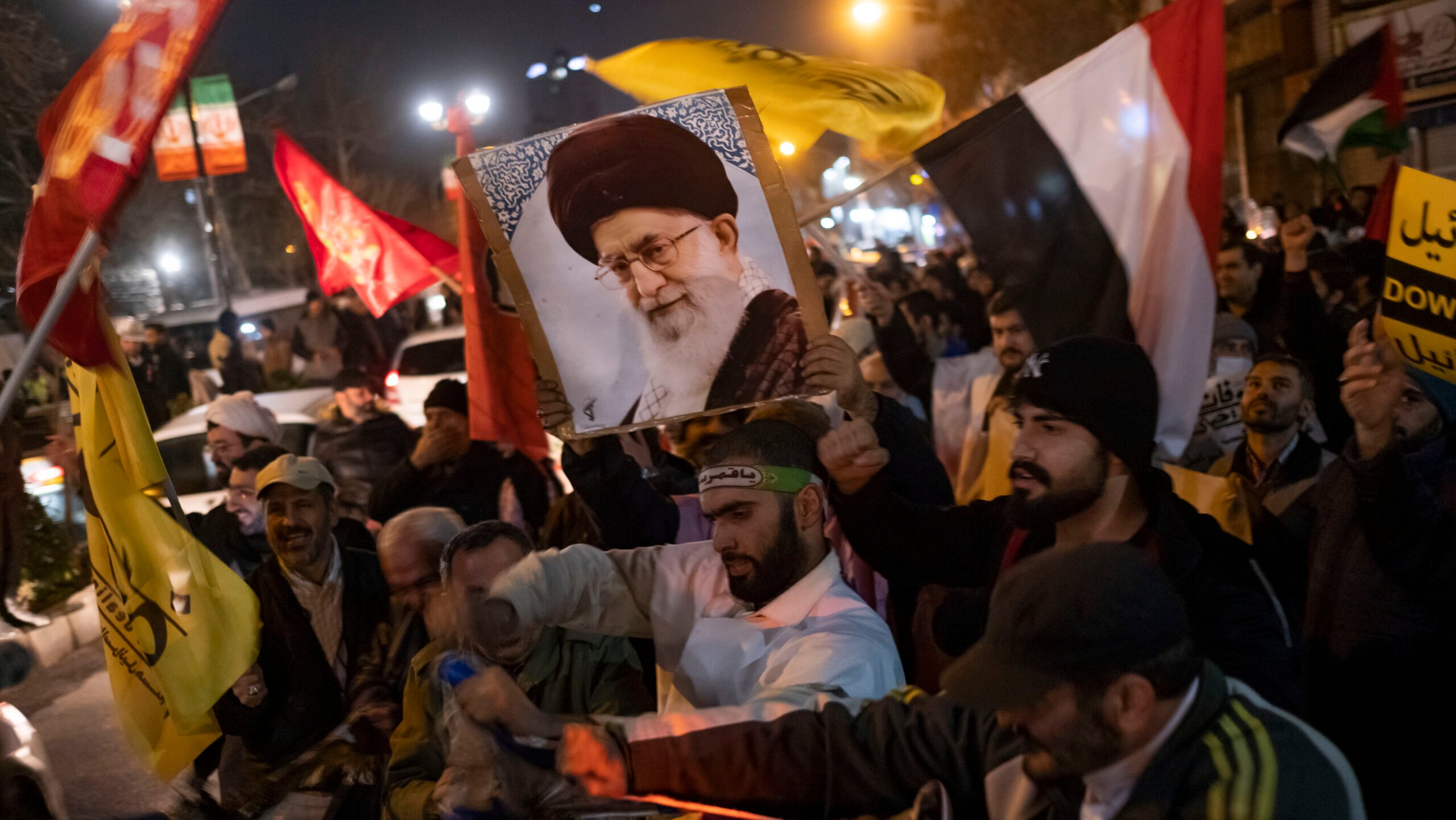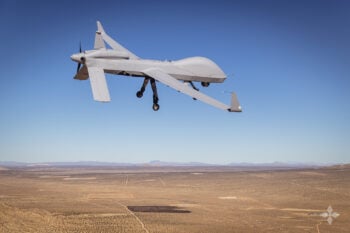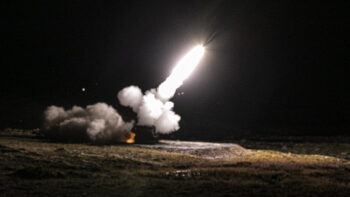
Iranian protesters are carrying a portrait of Iran’s Supreme Leader Ayatollah Ali Khamenei and a Yemeni flag as they tear an Israeli flag during an anti-U.S. and anti-British protest in front of the British embassy in downtown Tehran, Iran, on January 12, 2024. (Photo by Morteza Nikoubazl/NurPhoto via Getty Images)
DUBAI — The rapid escalation of violence by Iranian proxies against the US and Israel in the Middle East since Oct. 7 is the result of a failure of deterrence that reaches back into years of US foreign policy shifts and the lack of direct action against Iran for its aggressive behavior in that time, according to former top US general in the Middle East and other experts.
“I think the problem with all of these strikes (in Iraq, Syria and the Red Sea) is that we have failed to directly hold Iran accountable,” Gen. Joseph Votel, former US Central Command chief, told Breaking Defense. “We need to strike back at the groups perpetrating these attacks, but we also have to recognize that Iran is behind all these attacks, and we must use all forms of national power to hold them accountable.”
Ever since Hamas’s deadly surprise attack on Oct. 7 against Israeli military posts and settlements, Iranian proxies in Lebanon, Syria, Iraq and Yemen have launched a series of attacks that targeted Israeli territories and US bases in the Middle East, as well as commercial shipping in the Red Sea.
While Hezbollah has been exchanging rocket and gun fire daily with the Israelis on Lebanon’s southern border, pro-Iranian Shiite militias in Syria and Iraq have been firing rockets and explosives-laden drones against US bases there. The US says American bases in Syria and Iraq were attacked at least 150 times by Iranian proxies since Oct. 7. A drone attack on Jan. 28 resulted in the death of three US soldiers and the injury of dozens of others at a US installation in Jordan.
Meanwhile, Iranian-backed Houthi militiamen in Yemen have launched rocket attacks against Israel and have decided to target commercial ships in the Red Sea. The Houthi attacks have disrupted commercial shipping and prompted Washington to mobilize an international naval coalition to check the attacks and protect the ships in the area.
And though it’s unclear how much direct control Tehran has over the proxy forces that the US says it funds, trains and equips — and Iran has denied involvement with the violence — in the view of Votel and other experts a more robust deterrence of Iran is likely to have dissuaded much of the current violence.
According to Votel, who headed US forces in the Middle East between 2016 and 2019, there was a time the United States “did have an effective deterrence strategy that was primarily focused on the Iranian Nuclear Weapons Program.”
This strategy, he added, “brought the Iranians to the table for negotiations and prevented regional conflict between Israel and Iran. It was successful because we combined military pressure with significant diplomatic, informational, and economic actions.”
In Votel’s view, problems started when the US administration under President Barack Obama decided to “pivot” to Asia and reduced its involvement in the Middle East region.
“As we began to pull back from the region to focus on challenges in the Indo-Pacific, we did not put sufficient attention into maintaining this level of deterrence against Iranian malign behavior,” he said.
Furthermore, the Obama administration focused only on brokering an agreement on the Iranian nuclear program, which neglected the growing threat of its proxy groups in the region.
“Additionally, our main concern was about the Nuclear Program and not about all the other activities that Iran was pursuing, especially their robust support to proxies, and this, more than nuclear weapons, became Iran’s primary way of exporting their revolutionary ideology across the region,” added Votel.
Critics of the Iranian nuclear deal at the time said it didn’t do enough to restrict Iran’s “malign behavior” in the region unrelated to nuclear issues — an argument then-President Donald Trump made with he withdrew the US from the nuclear deal in 2018. (The Trump presidency mostly continued America’s pivot to the Pacific, with the notable exception of a drone strike that killed Iranian senior military official Gen. Qassem Soleimani in Baghdad in 2020, who Trump said “was plotting imminent and sinister attacks on American diplomats and military personnel.”)
Hasan Alhasan, senior fellow for Middle East policy at the International Institute for Strategic Studies, agreed with Votel’s analogy about the Pacific pivot.
“After witnessing a robust US deterrence under the administration of President George W. Bush in the Global War on Terrorism and the invasion of Iraq, the Obama pivot to Asia policy revealed a sharp drop of interest by Washington in the region, which encouraged Iran and its proxies to become bolder in their actions against American interests in the region,” Alhasan told Breaking Defense.
He pointed out that the sharp public differences between US officials over foreign policy and the worry of the American people of being sucked into another Middle East war were perceived by Iran “as signs of US weakness and encouraged Tehran to use its proxies to target American forces as well as US allies in the region.”
Bilal Saab, Senior Fellow and Director of Defense and Security Program at the Middle East Institute in Washington told Breaking Defense, “It’s hard to effectively implement deterrence if your adversary doesn’t believe you’re willing to escalate. America’s deterrence problem in the region is not about lack of firepower, it’s about lack of political will, and Iran can see that quite clearly.”
And though Israel’s attention never strayed far from Iran, experts said it’s deterrence strategy, too, had its limitations.
Hesham Youssef, a career diplomat and senior fellow at the U.S. Institute of Peace, believes that the Israeli deterrence policy towards Iran is very much linked to that of America.
“The Israeli calculations pertaining to Iran are much more complicated, as Israel cannot attack Iran without a green light from Washington,” Youssef said. “With the current challenges facing the Israeli coalition and society, Israel will not expand the scope of the war except if it is forced to do so.
“The current US administration has not been interested in a military escalation with Iran since it took office, and it is now entering the election cycle and unless the war spreads this situation will continue,” Youssef told Breaking Defense.
For many years Israel has adopted a deterrence strategy that has come to be known as the “campaign between wars,” largely based on carrying out limited pre-emptive strikes against Iranian proxies in neighboring countries to prevent them from acquiring advanced weapons or gain game-changing capabilities. (It also involved allegedly assassinating several Iranian nuclear scientists.)
It was successful, to a point.
“The main achievement of Israel’s campaign between the wars was thwarting the emergence in Syria of major formations of Syrian and Iraqi militias backed by a massive rocket array, like we see in possession of Hamas in Gaza and Hezbollah in Lebanon,” said Michael Eisenstadt, Kahn Fellow and director at the Military and Security Studies Program at the Washington Institute for Near East Policy. “Had that occurred, Israel would be fighting a three-front war (Gaza, Lebanon, Syria) and would possibly be dealing with ground assaults across the Golan – or at least large quantities of rocket fire from Syria.”
Retired Lebanese Army brigadier general and defense expert Khalil Helou agreed.
“The efficiency of the campaign between wars had a limited effect as a deterrent strategy, but on the other hand it contributed to the serious degradation of Hezbollah capabilities in Syria and Iraq — the capabilities that were intended to target Israel.”
But Ehud Yaari, the Lafer International Fellow at the Washington Institute for Near East Policy, said the “conflict between wars” policy failed to significantly rein in Hezbollah and Hamas — or convince Iran to hold them at bay.
Yaari pointed out that “Israel understands now that its deterrence is fragile so the lessons will follow.” He expected Israel to focus more on removing Iranian proxies from its borders, and believes that once Israel is done with Hamas, its next target will be Hezbollah — a potential next step in the current conflict for which Israel increasingly appears to be preparing and one feared by Lebanese civilians.
Israeli officials maintain that tens of thousands of Israeli settlers who fled their homes in northern Israel will not return home so long as Hezbollah fighters are at the borders, clearly suggesting they’ll have to be pushed back.
In the meantime, the US and Israel will also have to consider exactly what to do about the Shiite powerbroker in the region, Iran. Biden has not yet said how the US plans to respond to the proxy attack that killed three American servicemembers, and experts previously told Breaking Defense that striking Iran directly is most likely not a consideration for fear of a wider war. But Biden is under enormous pressure to do something.
“The main gap in Israel’s and the United States’s deterrence strategy toward Iran is the failure to impose direct costs on the Islamic Republic for its regional proxy strategy,” said Eisenstadt. “Filling this gap will require a new approach by Israel and the United States — one that finds a way to impose material costs on Iran — without leading to escalation and a broader conflict.”
Aloha: Fixes ongoing, then Army’s new watercraft prototype is Hawaii bound for testing
“Everything that we can knock off that list we will do in the archipelago…because that allows us to do the tests in the environment that the vessel will operate in ultimately,” said Maj. Gen. Jered Helwig.


























